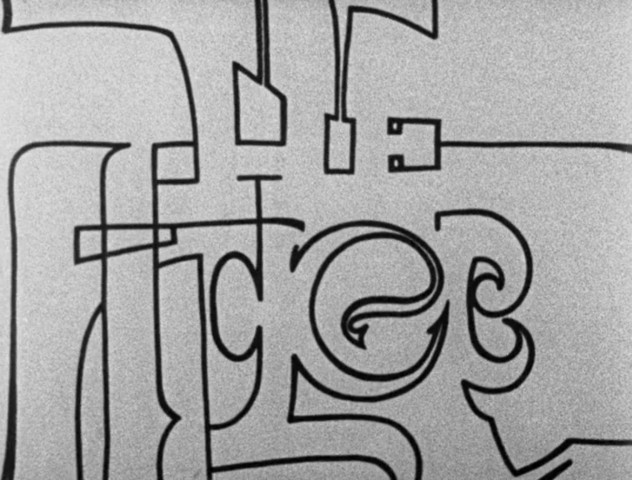Quote:
The most accomplished work of America’s foremost surrealist filmmaker. This is a hypnotic, obsessive nightmare of parricide and compulsive attempts to undo the deed. The basic images – the blood, the knife, the bread voraciously attacked – shock by their atavistic simplicity. The hallucinatory effect is reinforced by the extraordinary soundtrack, an enigmatic exploration of two old English ballads, scrambled in jam session style and interwoven with experimental sound.Read More »
Amos Vogel: Film as a Subversive Art
-
Sidney Peterson – The Lead Shoes (1949)
1941-1950Amos Vogel: Film as a Subversive ArtExperimentalShort FilmSidney PetersonUSA -
Peter Whitehead – Wholly Communion (1966)
1961-1970Amos Vogel: Film as a Subversive ArtDocumentaryExperimentalPeter WhiteheadUnited KingdomQuote:
On 11 June 1965, the Royal Albert Hall played host to a slew of American and European beat poets for an extraordinary impromptu event – the International Poetry Incarnation – that arguably marked the birth of London’s gestating counterculture. Cast in the role of historian, as a man-on-the-scene, and massively elevating his limited resources, Whitehead constructed the extraordinary Wholly Communion from the unfolding circus. As Allen Ginsberg, Lawrence Ferlinghetti, Gregory Corso, Harry Fainlight, Alexander Trocchi and others took to the stage, Whitehead confidently wandered with his borrowed camera, creating a participatory and anarchic film that is as much a landmark as the event itself, and launched his career.Read More » -
Gregory J. Markopoulos – Twice a Man (1963)
1961-1970Amos Vogel: Film as a Subversive ArtExperimentalGregory J. MarkopoulosQueer Cinema(s)Short FilmUSAQuote:
A modern recreation of the legend of Hyppolytus subtly reveals homosexual and incestual motives among its three protagonists as it mingles reality and memory. Particularly noteworthy is the attempt to portray thoughts and flashes of memory by inserting bursts of single-frame, almost subliminal shots into the main sequence which proceeds in different time and space.Read More » -
Hugh Burnett – Warsaw Ghetto (1965)
1961-1970Amos Vogel: Film as a Subversive ArtDocumentaryHugh BurnettUnited KingdomWarFrom Amos Vogel’s Film as a Subversive Art:
This secret Nazi film – unforgettable documentary of a vanquished world – was photographed just before the Ghetto’s total destruction and either never completed or not intended for public release. For once, the Nazis – albeit unintentionally – revealed the truth about an event, though it was a truth distorted by their presence; the only Jews who did not know that they were being photographed were the dead; the others, depending on degree of desperation, indifference, or nearness of death, attempted to smile or otherwise co-operate with the photographer/director (representative of unlimited power over life or death), an obscene spectacle difficult to bear. Read More » -
Warren Haack – Selective Service System (1970)
1971-1980Amos Vogel: Film as a Subversive ArtDocumentaryShort FilmUSAWarren HaackFrom Amos Vogel’s Film as a Subversive Art:
One of the most shocking documentary films ever made. A young anti-war American, to avoid the draft, calmly aims a rifle at his foot and shoots. For several, endless minutes he thrashes about the floor in unbearable pain, in his own blood. The filming continues. ‘There was no attempt to alter the proceedings that took place.’Read More » -
Army Pictorial Service, U.S. Signal Corps – The Atom Strikes! (1945)
1941-1950Amos Vogel: Film as a Subversive ArtDocumentaryHiroshima at 75Short FilmUSA

From Amos Vogel’s Film as a Subversive Art:
The explosions at Hiroshima and Nagasaki and their aftereffects are among the most widely photographed and most thoroughly suppressed events in history. While hundreds of thousands of feet were shot by scientific, military, and medical personnel, most of this material remains secreted in official archives. Significantly, this first official record (released only on a restricted basis) is confined to structural damage, and completely omits visual evidence of human casualties. The initially routine interview with a survivor (a Jesuit priest, also described in John Hersey’s book) becomes a horrifying reliving of the event when he recounts the actual bombing.Read More » -
George C. Stoney – All My Babies: A Midwife’s Own Story (1953)
USA1951-1960Amos Vogel: Film as a Subversive ArtDocumentaryGeorge C. StoneyFrom the DVD back cover:
‘All My Babies’ (1952) was selected in 2002 by the Librarian of Congress as a “culturally, historically, and artistically significant work” for permanent preservation in the National Film Registry.This beautiful film is the story of “Miss Mary” Coley, an African-American midwife more than half a century ago in rural Georgia. Conceived as a demonstration film for illiterate “granny” midwives, its production sponsored by the Georgia Department of Public Health, ‘All My Babies’ quickly transcended its initial purpose. It was used around the world by UNESCO and has become an enduring classic of non-fiction film.Read More »
-
Miklós Jancsó – La Tecnica e il rito (1972)
1971-1980Amos Vogel: Film as a Subversive ArtDramaItalyMiklós Jancsó

The narrative purports to deal with the barbaric exploits of Attila The Hun (an appropriately brooding if unsympathetic figure throughout)…and, yet, none of the characters ever leave the remote seaside stretch of land on which the film is set or do much of anything – with the ensuing moralizing interrupted only by the occasional (and equally obscure) music-infused rites! …..
by Mario GauciRead More » -
Tony Conrad – The Flicker (1965)
Tony Conrad1961-1970Amos Vogel: Film as a Subversive ArtExperimentalUSA






